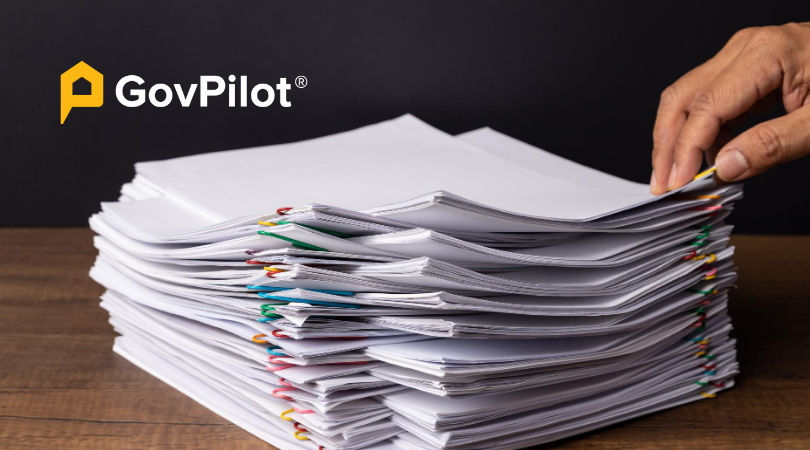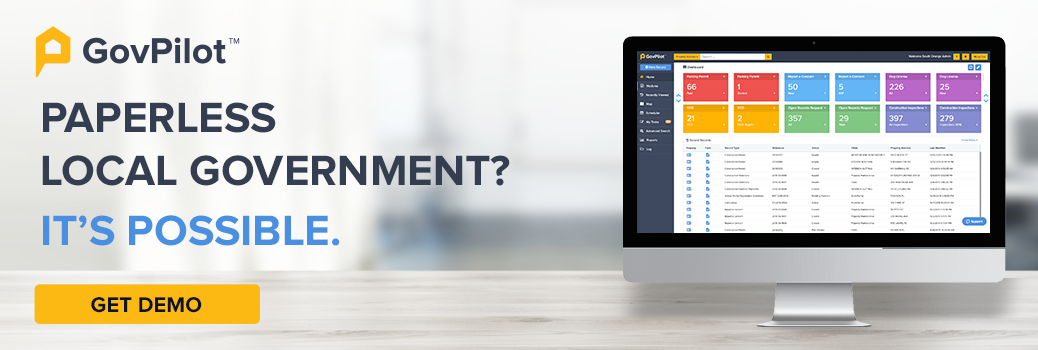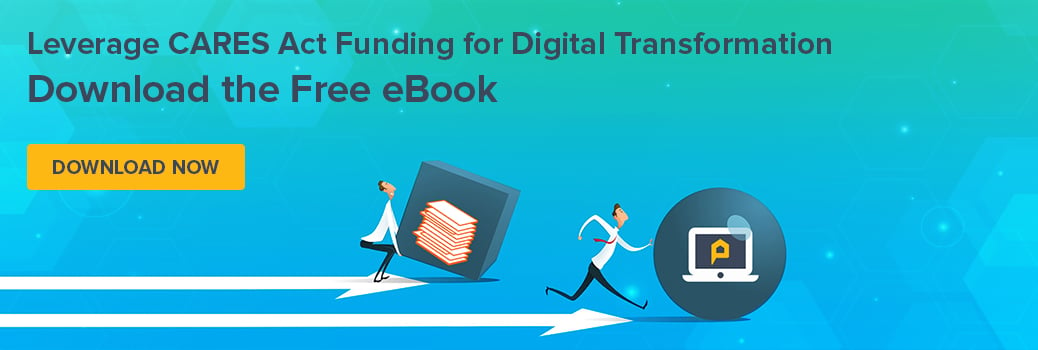In an era characterized by rapid modernization, increased constituent expectations, shrinking budgets, and unpredictable outside disruptions, local governments’ reliance on arcane paper-based processes drains its scarce resources and limits its ability to fully serve constituents.
Fortunately, government software for local governments is built to move paper-based processes to a digital format across departments to save time and money.
Here are thirteen reasons for local governments to embrace digital transformation and go paperless by moving public records and forms to an easy-to-navigate online capacity.
Online Constituent Experience
Improves Convenience
Consumers in modern society are accustomed to the ease of shopping, ordering food, booking travel, banking, and more all from their screens. They expect to be able to conduct business online. Paperless processes provide constituents with on-demand access to applications, information and other services that can now be completed via your government website rather than city hall. By digitizing operations, governments can more efficiently process claims, applications and license requests, resulting in higher constituent satisfaction.
Learn more about How Digital Government Services Work.
Promotes Transparency
Automated workflows promote transparency by automatically notifying constituents as each step of a government process is completed. Placing information in publicly searchable databases also saves government agencies time and money spent complying with open data requests.
How Does Government Accountability Encourage Transparency? Here's what to consider.
Efficiency and Productivity
Saves Employees Time
Documents are stored in the government cloud instead of in physical files, employees save time requesting documents from any municipal or county department, searching for misplaced reports and physically updating files. Staff meetings and local public meetings
When an inspector visits a property, he or she can view and update the property's file in real time via a government mobile field device. This cuts time needed to enter the data later and because the document is located in the cloud, granting instant access to updated information across departments.
Learn more about how government inspection software works in these helpful resources:
- Modern Local Government Building Inspection Strategy
- Modern Local Code Enforcement Strategy for Inspections & Beyond
- Government Retail Food Inspections: Protecting Public Health at Restaurants
Automates Tasks
Public record management automation cuts steps from a project’s journey to produce quicker results of a higher quality. Digital workflows enable government employees to track a project’s progress, automatically notify the correct people once a milestone is reached and create reminders so tasks are not stalled due to interdepartmental miscommunication. Digital forms, filled out by the public and employees, automatically populate databases with information, reducing the need for manual data entry.
Data is Accessible
With cloud-based government data storage, files can be located through simple queries, rather than through hours spent rummaging through cabinets full of physical paper in civic archives. Case workers can access and update files from their mobile devices. Property-specific data can be retrieved in real time from the municipality’s GIS platform, ensuring that every department has access to the most current information. Reports and analysis can automatically be generated in a matter of clicks via modern government analytics.
Unifies Departments
With centralized documents, all departments work together from the same information. Data and information silos are eliminated. Employees across all departments can access, manage and make decisions based on current and accurate data. The incidence of costly human error is reduced and communication bottlenecks are removed, facilitating seamless interdepartmental collaboration.
Learn more about embracing Modern Government Communications
Business Continuity
Improves Cyber Security
In the second half of 2019 alone there were 2,202 reported cyberattacks against local governments in the U.S. On-site servers are expensive to maintain and difficult to secure, and they’ve become the favorite target of cyber criminals who utilize ransomware to extract large sums of money from local governments. By transitioning to a cloud-based environment, records are stored securely and backed up several times per day. Maintenance and security costs are also eliminated, as the cloud provider becomes responsible for cybersecurity.
Here are helpful resources about how government software can keep your public data protected from hackers:
- Local Government Cyber Security: Prevent Ransomware Attacks
- Government Data Breach Prevention & Real-Life Examples
- How to Train Government Workers on Cyber Security Best Practices
Enables Business Continuity
From the mundane to the truly catastrophic, disruptions are bound to happen. Whether a blizzard or flood that closes roads making it impossible for employees to drive to the office, or a global pandemic which forces a months-long remote work policy, local governments must be able to operate regardless.
If government offices are closed, can services continue to be delivered? Can constituents submit applications? Would paper documents and files be safe in the event of a fire or flood? All of these potential crises must be considered in your city strategic planning.
In an age of increased and more destructive natural disasters, local governments are the first to respond. Business continuity and responsiveness is critical. Forego paper and securely store critical information in the cloud. Enable employees to access crucial data, from any location, through any device, at any time.
Digital transformation is a critical component of resilience. Here are other ways to mitigate against disaster:
- Local Government Disaster Preparedness Guide
- Tornado Mitigation & Disaster Plan
- Wildfire Mitigation & Disaster Plan
- Winter Storm Mitigation & Disaster Plan
- Landslide, Mudslide, & Rockslide Mitigation & Disaster Plan
Embrace a Hybrid Work Culture
Employees across sectors (especially tech) have grown accustomed to a remote working environment. As local governments battle to recruit talent, you can entice talent that enjoys working remotely by offering a hybrid government work structure.
The ability to work remotely and have access to information in the field is a critical modern work benefit that will entice tech-savvy employees.
Make HR's Recruitment Processes Easier
It is tough for local governments to compete against corporations with competitive salaries and benefits. Your government human resources department needs modern processes and technology to keep up.
Government HR software allows your local government to list job postings to your government website and keep track of application and interview processes in one simple to use platform.
Need more municipal and county recruitment tips? Here are helpful resources
- How to Recruit Government Employees
- How to Use Benefits to Entice Government Workers
- Local Government Employee Retention Strategy
Revenue & Budget Friendly
Cuts Costs
Digital document management eliminates the cost of printing and mailing documents to citizens. Online government fee and fine processing from GovPilot's integrated payment partners reduce transactions’ processing costs while making it easy for citizens and businesses to make critical payments. Increased productivity resulting from digitization defers cost over the workforce. Finally, the transition from on-site server-based platforms to cloud-based platforms can reduce maintenance and security costs.
Generate Unrealized Revenue
With records digitized and easily analyzed, employees can find opportunities to increase revenue for the budget. Are there 2,000 registered dog owners in your city? Pull a report and email a link for a $25 annual renewal payment each year - which residents will be able to pay directly through your website. That’s $50,000 added to the budget.
Here's the ultimate list of Revenue Generation Sources for Local Governments to Consider.
Saves Space
Save on storage! A cloud-based storage system requires no physical space! Papers related to such as FOIA and OPRA documents that are legally required to be stored and accessible for open record requests for seven years can be stored in the cloud rather than in rows of filing cabinets in office basements.
The Digital Transformation Process
Digital Transformation Journey
The term Digital Transformation is everywhere these days. Across industries the term is applied differently and often is in reference to technologies ranging from IT infrastructure, to big data, to machine learning and AI. Generally speaking however, Digital Transformation marks a radical rethinking of how an organization uses technology, people and processes to fundamentally change business performance.
It is important to remember that digital transformation is a journey. It does not happen all at once or overnight. It happens in steps and phases as new technology is implemented and continually improved, as employees are trained and adopt modern government IT systems, and as organizational culture shifts from manual processes to digital systems. GovPilot has onboarding professionals to assist in your transition to digital governance in as smooth and straightforward of a manner as possible.
Learn more about How Onboarding Government Software Works.
New Technology
Over the last decade, a wide range of industries have replaced their paper-based processes with digital applications to incredible effect. Importantly for governments, removing paper processes promotes efficiency and productivity. Files are stored in the cloud, safe from cyber and physical threats. The ubiquity of WIFI and mobile devices means that data can be accessed and updated by employees at any time, from anywhere. Time previously spent locating paper files and performing data entry can be dedicated to addressing higher level matters. Services can be rendered to constituents quickly and transparently.
Of all sectors, government may have the most to gain from investing in new technology and going paperless. Local governments, subject to frequent budget cuts and restrictions on revenue generation, can conserve scant resources and even boost productivity through digitization. Digitization can also improve relations with a constituent base growing increasingly accustomed to immediate, 24/7 service as a standard component of the customer experience.
Ultimately, cloud-based government management platforms like GovPilot are capable of delivering the flexibility, security, and affordability that local governments require to improve both constituent services and budgets.
Interested in learning more?
Our Solutions Specialists are ready to speak with you about your government's current processes and needs, and make recommendations that are specifically tailored to your local government. Schedule a FREE 15-minute consultation. Let's talk!
Local governments across the U.S. have found success with GovPilot. Read our Case Studies and these latest resources from the Government Trends & Technology blog:
- Actionable Tips for City Administrators
- Local Code Enforcement Technology & Workflows
- Modern Fleet Management Workflows for Local Governments
- How Counties & Municipalities Can Drive Local Economic Development
- How Local Governments Benefit From Broadband Internet
- What to Look for in Government Procurement Technology
- Government IT Strategy: How to Modernize IT Ticketing
- Judicial Software: How to Digitize Your Local Courthouse
- Local Law Enforcement Software: Digitizing Police Processes
- Modern Parks & Recreation Department Strategy
- Actionable Tips for Local Public Health Directors
Sources:











